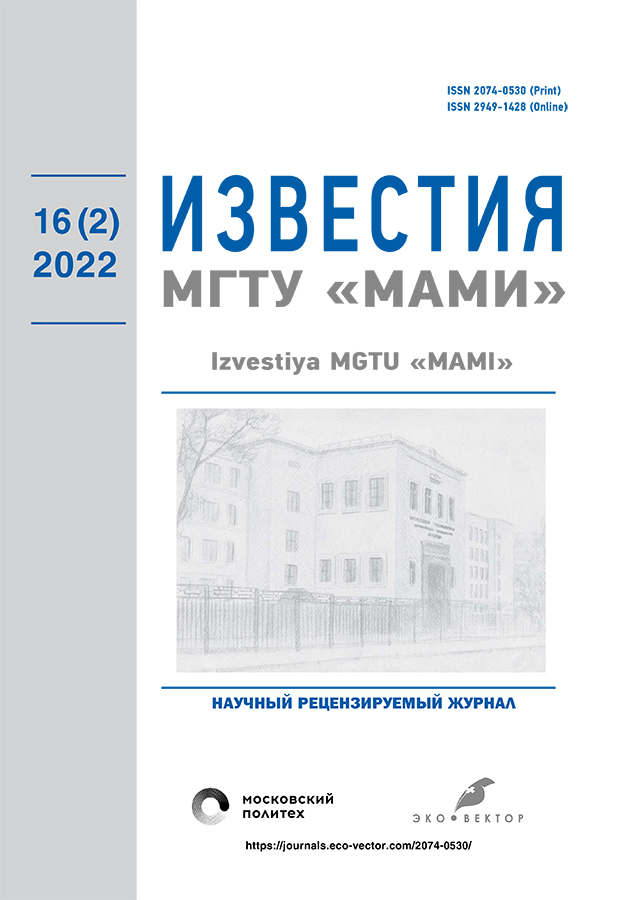An energy efficiency analysis of the electrodynamic antispin regulation of the city electrobus
- Authors: Zhileykin M.M.1, Klimov A.V.1, Maslennikov I.K.1
-
Affiliations:
- KAMAZ Innovation Center
- Issue: Vol 16, No 2 (2022)
- Pages: 161-171
- Section: Transport and transport-technological facilities
- URL: https://journals.eco-vector.com/2074-0530/article/view/96733
- DOI: https://doi.org/10.17816/2074-0530-96733
- ID: 96733
Cite item
Abstract
BACKGROUND: The antispin regulation (ASR) operation, combined with an individual electric traction drive (IETD) of a city electrobus, may contribute to road safety improvement as well as to economy of electric energy, consumed by IETD from drive battery as a result of decreasing of drving wheels spin.
AIMS: Development of a new operation algorithm of the electrodynamic ASR of the rear axle driven electrobus, based on additional modulation of the vectoral PWM signal, applied to three-phase windings of a stator of a synchronous traction motor and helping to ensure electroenergy economy as a result of consumption decrease and partial energy return during driving wheels regenerative braking,as well as improvement of driving stability on slippery roads.
METHODS: The chosen criterion of operating capability of the ASR operation algorithm is absence of negative impact on road safety, which may consist in loss of course and trajectory driving stability and loss of mobility. Electrobus motion path was used as an integrational measuring tool for quality assessment of these performance characteristics. The chosen criteria of energy efficiency are the summarized averaged electric power, consumed by traction motors, and the summarized averaged electrical power of regeneration, returned by traction motors to the battery throughout the electrobus testing ride.
RESULTS: With simulation methods, it was found that the summarized averaged power of the electrobus, featured with the ASR, driving on slippery road, is 9.7% less than the power of the electrobus without the ASR in the same conditions.
CONCLUSIONS: The summarized economy, resulted from decreasing of energy consumption (driving wheels spin is eliminated) and partial energy return back to a battery during driving wheels regenerative braking, may be up to 26.8% of the summarized averaged electric power, consumed by traction motors of the electrobus with the ASR.
Full Text
About the authors
Mikhail M. Zhileykin
KAMAZ Innovation Center
Author for correspondence.
Email: ZhileykinMM@kamaz.ru
ORCID iD: 0000-0002-8851-959X
SPIN-code: 6561-3300
Dr. Sci. (Tech.), Head of the Engineering Calculations Group
Russian Federation, MoscowAlexandr V. Klimov
KAMAZ Innovation Center
Email: Aleksandr.Klimov@kamaz.ru
ORCID iD: 0000-0002-5351-3622
SPIN-code: 7637-3104
Cand. Sci. (Tech.), Head of the Electrified Car Service
Russian Federation, MoscowIvan K. Maslennikov
KAMAZ Innovation Center
Email: MaslennikovIK@kamaz.ru
ORCID iD: 0000-0003-3879-0098
SPIN-code: 5320-2940
Leading Software Engineer
Russian Federation, MoscowReferences
- Zhan W, Liu C, Chan C-Y, et al. A non-conservatively defensive strategy for urban autonomous driving. 2016 IEEE 19th International Conference on Intelligent Transportation Systems (ITSC). 2016:459–464.
- Paden B, Cap M, Yong SZ, et al. A Survey of Motion Planning and Control Techniques for Self-Driving Urban Vehicles. IEEE Transactions on Intelligent Vehicles. 2016;1(1):33–55. doi: 10.1109/tiv.2016.2578706
- Qian X, de La Fortelle A, Moutarde F. A hierarchical Model Predictive Control framework for on-road formation control of autonomous vehicles. 2016 IEEE Intelligent Vehicles Symposium (IV). 2016. P. 376–381. doi: 10.1109/IVS.2016.7535413
- Kuwata Y, Karaman S, Teo J, et al. Real-Time Motion Planning With Applications to Autonomous Urban Driving. IEEE Transactions on Control Systems Technology. 2009;17(5):1105–1118. doi: 10.1109/tcst.2008.2012116
- Chang CS, Sim SS. Optimising train movements through coast control using genetic algorithms. IEE Proceedings – Electric Power Applications. 1997;144(1). doi: 10.1049/ip-epa:19970797
- Kotiev GO, Butarovich DO, Kositsyn BB. Energy efficient motion control of the electric bus on route. IOP Conference Series: Materials Science and Engineering. 2018;315. doi: 10.1088/1757-899x/315/1/012014
- Zhileikin MM, Kotiev GO. Modelirovanie sistem transportnykh sredstv: uchebnik. Moscоw: Izd-vo MGTU im. N.E. Baumana; 2020. (In Russ).
- Zhileikin MM. Teoreticheskie osnovy povysheniya pokazatelei ustoichivosti i upravlyaemosti kolesnykh mashin na baze metodov nechetkoi logiki. Moscоw: Izd-vo MGTU im. N.E. Baumana; 2016. (In Russ).
- Afanas’ev BA et al. Proektirovanie polnoprivodnykh kolesnykh mashin: Uchebnik dlya vuzov. Moscоw: Izd-vo MGTU im. N.E. Baumana; 2008. (In Russ).
- Anuchin AS. Sistemy upravleniya elektroprivodov: uchebnik dlya vuzov. Moscоw: Izd. dom MEI; 2015. (In Russ).
Supplementary files




















